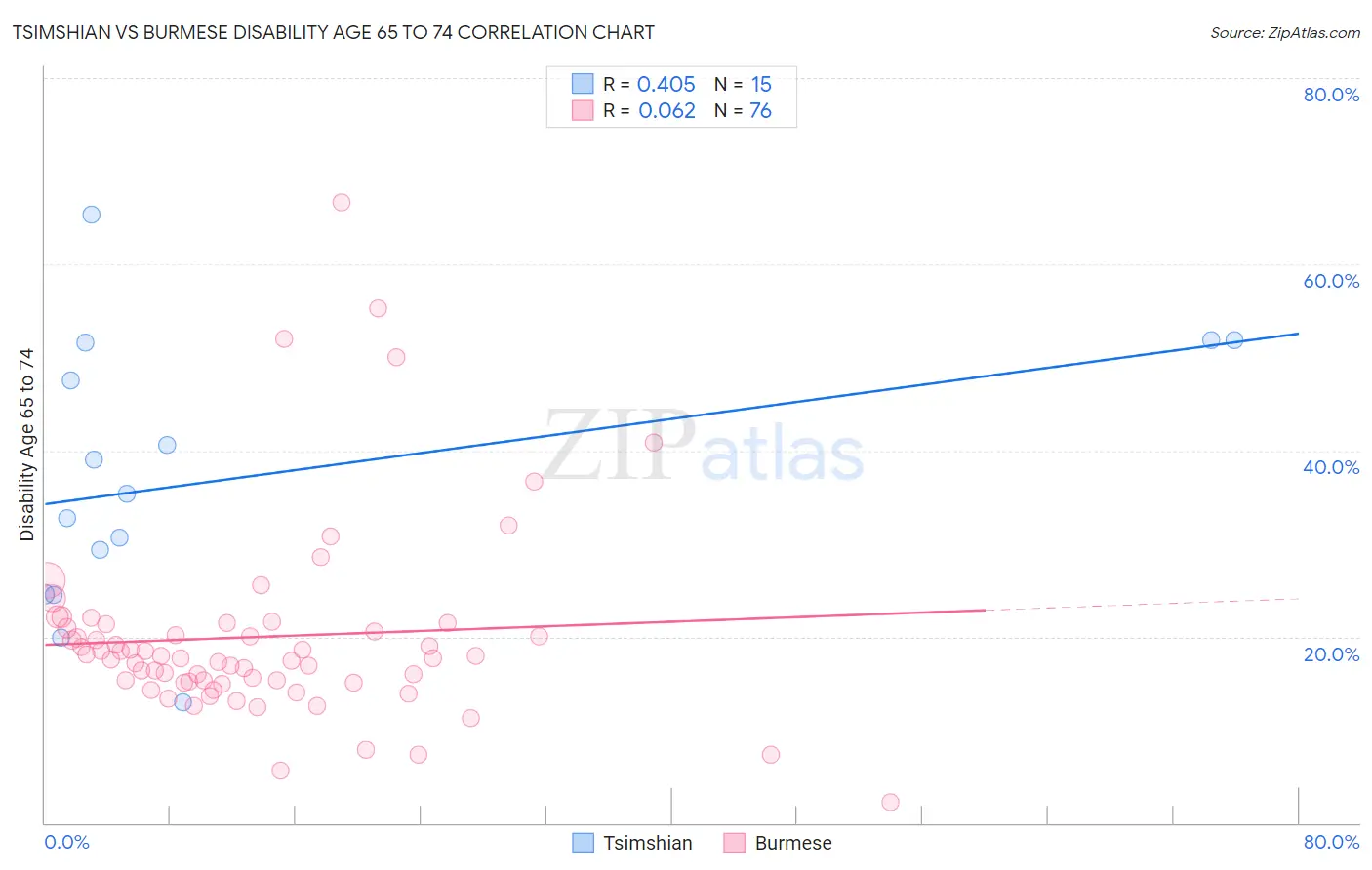Tsimshian vs Burmese Disability Age 65 to 74
COMPARE
Tsimshian
Burmese
Disability Age 65 to 74
Disability Age 65 to 74 Comparison
Tsimshian
Burmese
32.9%
DISABILITY AGE 65 TO 74
0.0/ 100
METRIC RATING
341st/ 347
METRIC RANK
20.6%
DISABILITY AGE 65 TO 74
100.0/ 100
METRIC RATING
19th/ 347
METRIC RANK
Tsimshian vs Burmese Disability Age 65 to 74 Correlation Chart
The statistical analysis conducted on geographies consisting of 15,620,176 people shows a moderate positive correlation between the proportion of Tsimshian and percentage of population with a disability between the ages 65 and 75 in the United States with a correlation coefficient (R) of 0.405 and weighted average of 32.9%. Similarly, the statistical analysis conducted on geographies consisting of 463,915,449 people shows a slight positive correlation between the proportion of Burmese and percentage of population with a disability between the ages 65 and 75 in the United States with a correlation coefficient (R) of 0.062 and weighted average of 20.6%, a difference of 59.5%.

Disability Age 65 to 74 Correlation Summary
| Measurement | Tsimshian | Burmese |
| Minimum | 13.0% | 2.2% |
| Maximum | 65.3% | 66.7% |
| Range | 52.3% | 64.5% |
| Mean | 37.2% | 20.0% |
| Median | 35.4% | 17.8% |
| Interquartile 25% (IQ1) | 24.6% | 15.2% |
| Interquartile 75% (IQ3) | 51.6% | 21.1% |
| Interquartile Range (IQR) | 27.0% | 5.9% |
| Standard Deviation (Sample) | 14.4% | 10.6% |
| Standard Deviation (Population) | 13.9% | 10.5% |
Similar Demographics by Disability Age 65 to 74
Demographics Similar to Tsimshian by Disability Age 65 to 74
In terms of disability age 65 to 74, the demographic groups most similar to Tsimshian are Lumbee (32.7%, a difference of 0.53%), Pueblo (33.1%, a difference of 0.60%), Kiowa (32.6%, a difference of 1.1%), Navajo (33.3%, a difference of 1.3%), and Alaskan Athabascan (32.4%, a difference of 1.7%).
| Demographics | Rating | Rank | Disability Age 65 to 74 |
| Colville | 0.0 /100 | #333 | Tragic 30.5% |
| Alaska Natives | 0.0 /100 | #334 | Tragic 30.6% |
| Cheyenne | 0.0 /100 | #335 | Tragic 31.1% |
| Yuman | 0.0 /100 | #336 | Tragic 31.5% |
| Houma | 0.0 /100 | #337 | Tragic 32.3% |
| Alaskan Athabascans | 0.0 /100 | #338 | Tragic 32.4% |
| Kiowa | 0.0 /100 | #339 | Tragic 32.6% |
| Lumbee | 0.0 /100 | #340 | Tragic 32.7% |
| Tsimshian | 0.0 /100 | #341 | Tragic 32.9% |
| Pueblo | 0.0 /100 | #342 | Tragic 33.1% |
| Navajo | 0.0 /100 | #343 | Tragic 33.3% |
| Inupiat | 0.0 /100 | #344 | Tragic 34.5% |
| Tohono O'odham | 0.0 /100 | #345 | Tragic 36.0% |
| Yup'ik | 0.0 /100 | #346 | Tragic 37.8% |
| Pima | 0.0 /100 | #347 | Tragic 38.6% |
Demographics Similar to Burmese by Disability Age 65 to 74
In terms of disability age 65 to 74, the demographic groups most similar to Burmese are Eastern European (20.6%, a difference of 0.030%), Immigrants from South Central Asia (20.6%, a difference of 0.10%), Okinawan (20.7%, a difference of 0.32%), Immigrants from Lithuania (20.5%, a difference of 0.35%), and Paraguayan (20.5%, a difference of 0.41%).
| Demographics | Rating | Rank | Disability Age 65 to 74 |
| Immigrants | Korea | 100.0 /100 | #12 | Exceptional 20.4% |
| Immigrants | Singapore | 100.0 /100 | #13 | Exceptional 20.4% |
| Indians (Asian) | 100.0 /100 | #14 | Exceptional 20.5% |
| Paraguayans | 100.0 /100 | #15 | Exceptional 20.5% |
| Immigrants | Lithuania | 100.0 /100 | #16 | Exceptional 20.5% |
| Immigrants | South Central Asia | 100.0 /100 | #17 | Exceptional 20.6% |
| Eastern Europeans | 100.0 /100 | #18 | Exceptional 20.6% |
| Burmese | 100.0 /100 | #19 | Exceptional 20.6% |
| Okinawans | 100.0 /100 | #20 | Exceptional 20.7% |
| Immigrants | Bolivia | 99.9 /100 | #21 | Exceptional 20.8% |
| Immigrants | Iran | 99.9 /100 | #22 | Exceptional 20.9% |
| Immigrants | Belgium | 99.9 /100 | #23 | Exceptional 21.0% |
| Soviet Union | 99.9 /100 | #24 | Exceptional 21.0% |
| Bolivians | 99.9 /100 | #25 | Exceptional 21.0% |
| Immigrants | Australia | 99.9 /100 | #26 | Exceptional 21.0% |